Metal–Organic Framework-Derived Mn/Ni Dual-Metal Single-Atom Catalyst for Efficient Oxygen Reduction Reaction
Abstract
1. Introduction
2. Results
3. Materials and Methods
3.1. Chemical Reagents and Materials
3.2. Preparation of Mn-Bpy Precursor
3.3. Preparation of Ni-Bpy Precursor
3.4. Preparation of MnNi-Bpy Precursor
3.5. Preparation of MnNC, NiNC, MNNC-1, MNNC-2 and MNNC-3
3.6. Preparation of Contrast Samples
3.7. Characterization
3.8. Electrochemical Measurements
4. Conclusions
Supplementary Materials
Author Contributions
Funding
Data Availability Statement
Conflicts of Interest
References
- Gao, L.; Xiao, M.; Jin, Z.; Liu, C.; Zhu, J.; Ge, J.; Xing, W. Correlating Fe Source with Fe-N-C Active Site Construction: Guidance for Rational Design of High-Performance ORR Catalyst. J. Energy Chem. 2018, 27, 1668–1673. [Google Scholar] [CrossRef]
- Debe, M.K. Electrocatalyst Approaches and Challenges for Automotive Fuel Cells. Nature 2012, 486, 43–51. [Google Scholar] [CrossRef]
- Lu, F.; Fan, K.; Cui, L.; Yang, Y.; Wang, W.; Zhang, G.; Wang, C.; Zhang, Q.; Li, B.; Zong, L.; et al. Cu-N4 Single Atoms Derived from Metal-Organic Frameworks with Trapped Nitrogen-Rich Molecules and Their use as Efficient Electrocatalysts for Oxygen Reduction Reaction. Chem. Eng. J. 2022, 431, 133242. [Google Scholar] [CrossRef]
- Wang, Z.L.; Xu, D.; Xu, J.J.; Zhang, X.B. Oxygen Electrocatalysts in Metal-air Batteries: From Aqueous to Nonaqueous Electrolytes. Chem. Soc. Rev. 2014, 43, 7746–7786. [Google Scholar] [CrossRef]
- Cao, R.; Lee, J.-S.; Liu, M.; Cho, J. Non-Precious Catalysts: Recent Progress in Non-Precious Catalysts for Metal-Air Batteries. Adv. Energy Mater. 2012, 2, 701. [Google Scholar] [CrossRef]
- Cheng, F.; Chen, J. Metal-Air Batteries: From Oxygen Reduction Electrochemistry to Cathode Catalysts. Chem. Soc. Rev. 2012, 41, 2172–2192. [Google Scholar] [CrossRef] [PubMed]
- Yu, D.; Ma, Y.; Hu, F.; Lin, C.C.; Li, L.; Chen, H.Y.; Han, X.; Peng, S. Dual-Sites Coordination Engineering of Single Atom Catalysts for Flexible Metal–Air Batteries. Adv. Energy Mater. 2021, 11, 2100219. [Google Scholar] [CrossRef]
- Ma, S.; Yuan, G.; Zhang, Y.; Yang, N.; Li, Y.; Chen, Q. Development of Encapsulation Strategies Towards the Commercialization of Perovskite Solar Cells. Energy Environ. Sci. 2022, 15, 13–55. [Google Scholar] [CrossRef]
- Lin, Z.; Xiao, B.; Wang, Z.; Tao, W.; Shen, S.; Huang, L.; Zhang, J.; Meng, F.; Zhang, Q.; Gu, L.; et al. Planar-Coordination PdSe2 Nanosheets as Highly Active Electrocatalyst for Hydrogen Evolution Reaction. Adv. Funct. Mater. 2021, 31, 2102321. [Google Scholar] [CrossRef]
- Jiang, R.; Li, L.; Sheng, T.; Hu, G.; Chen, Y.; Wang, L. Edge-Site Engineering of Atomically Dispersed Fe-N4 by Selective C-N Bond Cleavage for Enhanced Oxygen Reduction Reaction Activities. J. Am. Chem. Soc. 2018, 140, 11594–11598. [Google Scholar] [CrossRef]
- Wu, H.; Wu, J.; Li, Y.; Li, W.; Zhai, J.; Jiang, Q.; Xu, X.; Gao, Y. Enhanced Oxygen Reduction with Carbon-Polyhedron-Supported Discrete Cobalt-Nitrogen Sites for Zn-Air Batteries. Chem. Eng. J. 2022, 431, 134084. [Google Scholar] [CrossRef]
- Faraji, M.; Dehaghi, S.M. Pd-Doped g-C3N4 Decorated by Nitrogen-Doped Carbon Quantum Dot as a High Performance Electrocatalyst with Superior Durability and Methanol Tolerance for Oxygen Reduction Reaction. Inorg. Chem. Commun. 2021, 123, 108328. [Google Scholar] [CrossRef]
- Marković, N.M.; Schmidt, T.J.; Stamenković, V.; Ross, P.N. Oxygen Reduction Reaction on Pt and Pt Bimetallic Surfaces: A Selective Review. Fuel Cells 2001, 1, 105–116. [Google Scholar] [CrossRef]
- Nie, Y.; Li, L.; Wei, Z. Recent Advancements in Pt and Pt-Free Catalysts for Oxygen Reduction Reaction. Chem. Soc. Rev. 2015, 44, 2168–2201. [Google Scholar] [CrossRef]
- Dai, L.; Xue, Y.; Qu, L.; Choi, H.J.; Baek, J.B. Metal-Free Catalysts for Oxygen Reduction Reaction. Chem. Rev. 2015, 115, 4823–4892. [Google Scholar] [CrossRef]
- Wang, Y.J.; Zhao, N.; Fang, B.; Li, H.; Bi, X.T.; Wang, H. Carbon-Supported Pt-Based Alloy Electrocatalysts for the Oxygen Reduction Reaction in Polymer Electrolyte Membrane Fuel Cells: Particle Size, Shape, and Composition Manipulation and Their Impact to Activity. Chem. Rev. 2015, 115, 3433–3467. [Google Scholar] [CrossRef] [PubMed]
- Huang, H.; Yu, D.; Hu, F.; Huang, S.C.; Song, J.; Chen, H.Y.; Li, L.L.; Peng, S. Clusters Induced Electron Redistribution to Tune Oxygen Reduction Activity of Transition Metal Single-Atom for Metal-Air Batteries. Angew. Chem. Int. Ed. 2022, 61, e202116068. [Google Scholar]
- Ma, S.; Deng, J.; Xu, Y.; Tao, W.; Wang, X.; Lin, Z.; Zhang, Q.; Gu, L.; Zhong, W. Pollen-Like Self-Supported FeIr Alloy for Improved Hydrogen Evolution Reaction in Acid Electrolyte. J. Energy Chem. 2022, 66, 560–565. [Google Scholar] [CrossRef]
- Shang, H.; Sun, W.; Sui, R.; Pei, J.; Zheng, L.; Dong, J.; Jiang, Z.; Zhou, D.; Zhuang, Z.; Chen, W.; et al. Engineering Isolated Mn-N2C2 Atomic Interface Sites for Efficient Bifunctional Oxygen Reduction and Evolution Reaction. Nano Lett. 2020, 20, 5443–5450. [Google Scholar] [CrossRef]
- Wang, H.F.; Chen, L.; Pang, H.; Kaskel, S.; Xu, Q. MOF-Derived Electrocatalysts for Oxygen Reduction, Oxygen Evolution and Hydrogen Evolution Reactions. Chem. Soc. Rev. 2020, 49, 1414–1448. [Google Scholar] [CrossRef]
- Xu, H.; Cheng, D.; Cao, D.; Zeng, X.C. A Universal Principle for A Rational Design of Single-Atom Electrocatalysts. Nat. Catal. 2018, 1, 339–348. [Google Scholar] [CrossRef]
- Ling, C.; Shi, L.; Ouyang, Y.; Zeng, X.C.; Wang, J. Nanosheet Supported Single-Metal Atom Bifunctional Catalyst for Overall Water Splitting. Nano Lett. 2017, 17, 5133–5139. [Google Scholar] [CrossRef] [PubMed]
- Zhang, L.; Si, R.; Liu, H.; Chen, N.; Wang, Q.; Adair, K.; Wang, Z.; Chen, J.; Song, Z.; Li, J.; et al. Atomic Layer Deposited Pt-Ru Dual-Metal Dimers and Identifying Their Active Sites for Hydrogen Evolution Reaction. Nat. Commun. 2019, 10, 4936. [Google Scholar] [CrossRef]
- Zhang, J.; Huang, Q.-A.; Wang, J.; Wang, J.; Zhang, J.; Zhao, Y. Supported Dual-Atom Catalysts: Preparation, Characterization, and Potential Applications. Chin. J. Catal. 2020, 41, 783–798. [Google Scholar] [CrossRef]
- Cai, H.; Zhang, G.; Zhang, X.; Chen, B.; Lu, Z.; Xu, H.; Gao, R.; Shi, C. Engineering the Local Coordination Environment and Density of FeN4 Sites by Mn Cooperation for Electrocatalytic Oxygen Reduction. Small 2022, 18, e2200911. [Google Scholar] [CrossRef]
- Han, X.; Ling, X.; Yu, D.; Xie, D.; Li, L.; Peng, S.; Zhong, C.; Zhao, N.; Deng, Y.; Hu, W. Atomically Dispersed Binary Co-Ni Sites in Nitrogen-Doped Hollow Carbon Nanocubes for Reversible Oxygen Reduction and Evolution. Adv. Mater. 2019, 31, e1905622. [Google Scholar] [CrossRef] [PubMed]
- Han, X.; Zhang, T.; Chen, W.; Dong, B.; Meng, G.; Zheng, L.; Yang, C.; Sun, X.; Zhuang, Z.; Wang, D.; et al. Mn-N4 Oxygen Reduction Electrocatalyst: Operando Investigation of Active Sites and High Performance in Zinc-Air Battery. Adv. Energy Mater. 2020, 11, 2002753. [Google Scholar] [CrossRef]
- Liu, W.; Zhang, L.; Liu, X.; Liu, X.; Yang, X.; Miao, S.; Wang, W.; Wang, A.; Zhang, T. Discriminating Catalytically Active FeNx Species of Atomically Dispersed Fe-N-C Catalyst for Selective Oxidation of the C-H Bond. J. Am. Chem. Soc. 2017, 139, 10790–10798. [Google Scholar] [CrossRef]
- Lang, L.; Shi, Y.; Wang, J.; Wang, F.; Xia, X. Hollow Core-Shell Structured Ni-Sn@C Nanoparticles: A Novel Electrocatalyst for the Hydrogen Evolution Reaction. ACS Appl. Mater. Interfaces 2015, 7, 9098–9102. [Google Scholar] [CrossRef]
- Wang, X.X.; Cullen, D.A.; Pan, Y.T.; Hwang, S.; Wang, M.; Feng, Z.; Wang, J.; Engelhard, M.H.; Zhang, H.; He, Y.; et al. Nitrogen-Coordinated Single Cobalt Atom Catalysts for Oxygen Reduction in Proton Exchange Membrane Fuel Cells. Adv. Mater. 2018, 30, 1706758. [Google Scholar] [CrossRef]
- Zou, L.; Wei, Y.S.; Hou, C.C.; Li, C.; Xu, Q. Single-Atom Catalysts Derived from Metal-Organic Frameworks for Electrochemical Applications. Small 2021, 17, e2004809. [Google Scholar] [CrossRef] [PubMed]
- Cao, B.; Zeng, L.; Liu, H.; Shang, J.; Wang, L.; Lang, J.; Cao, X.; Gu, H. Synthesis of the Platinum Nanoribbons Regulated by Fluorine and Applications in Electrocatalysis. Inorg. Chem. 2021, 60, 4366–4370. [Google Scholar] [CrossRef] [PubMed]
- Singh, B.; Sharma, V.; Gaikwad, R.P.; Fornasiero, P.; Zbořil, R.; Gawande, M.B. Single-Atom Catalysts: A Sustainable Pathway for the Advanced Catalytic Applications. Small 2021, 17, e2006473. [Google Scholar] [CrossRef] [PubMed]
- Qu, X.; Han, Y.; Chen, Y.; Lin, J.; Li, G.; Yang, J.; Jiang, Y.; Sun, S. Stepwise Pyrolysis Treatment as An Efficient Strategy to Enhance the Stability Performance of Fe-NX/C Electrocatalyst Towards Oxygen Reduction Reaction and Proton Exchange Membrane Fuel Cell. Appl. Catal. B 2021, 295, 2101242. [Google Scholar] [CrossRef]
- Wang, Q.; Yang, Y.; Sun, F.; Chen, G.; Wang, J.; Peng, L.; Chen, W.T.; Shang, L.; Zhao, J.; Sun-Waterhouse, D.; et al. Molten NaCl-Assisted Synthesis of Porous Fe-N-C Electrocatalysts with a High Density of Catalytically Accessible FeN4 Active Sites and Outstanding Oxygen Reduction Reaction Performance. Adv. Energy Mater. 2021, 11, 2101242. [Google Scholar]
- Li, J.; Chen, M.; Cullen, D.A.; Hwang, S.; Wang, M.; Li, B.; Liu, K.; Karakalos, S.; Lucero, M.; Zhang, H.; et al. Atomically Dispersed Manganese Catalysts for Oxygen Reduction in Proton-Exchange Membrane Fuel Cells. Nat. Catal. 2018, 1, 935–945. [Google Scholar] [CrossRef]
- Shi, Y.; Tada, E.; Nishikata, A. Erratum: A Method for Determining the Corrosion Rate of a Metal under a Thin Electrolyte Film. J. Electrochem. Soc. 2017, 164, X10. [Google Scholar] [CrossRef]
- Thompson, S.T.; Wilson, A.R.; Zelenay, P.; Myers, D.J.; More, K.L.; Neyerlin, K.; Papageorgopoulos, D. ElectroCat: DOE’s Approach to PGM-Free Catalyst and Electrode R&D. Solid State Ion. 2018, 319, 68–76. [Google Scholar]
- Guo, L.; Hwang, S.; Li, B.; Yang, F.; Wang, M.; Chen, M.; Yang, X.; Karakalos, S.G.; Cullen, D.; Feng, Z.; et al. Promoting Atomically Dispersed MnN4 Sites via Sulfur Doping for Oxygen Reduction: Unveiling Intrinsic Activity and Degradation in Fuel Cells. ACS Nano 2021, 15, 6886–6899. [Google Scholar] [CrossRef]
- Liu, K.; Qiao, Z.; Hwang, S.; Liu, Z.; Zhang, H.; Su, D.; Xu, H.; Wu, G.; Wang, G. Mn- and N- doped Carbon as Promising Catalysts for Oxygen Reduction Reaction: Theoretical Prediction and Experimental Validation. Appl. Catal. B 2019, 243, 195–203. [Google Scholar] [CrossRef]
- Zhang, S.; Xue, H.; Li, W.; Sun, J.; Guo, N.; Song, T.; Dong, H.; Zhang, J.; Ge, X.; Zhang, W.; et al. Constructing Precise Coordination of Nickel Active Sites on Hierarchical Porous Carbon Framework for Superior Oxygen Reduction. Small 2021, 17, e2102125. [Google Scholar] [CrossRef]
- Wang, D.; Liu, J.; Xi, J.; Jiang, J.; Bai, Z. Pd-Fe Dual-metal Nanoparticles Confined in the Interface of Carbon Nanotubes/N-doped Carbon for Excellent Catalytic Performance. Appl. Surf. Sci. 2019, 489, 477–484. [Google Scholar] [CrossRef]
- Xu, J.; Elangovan, A.; Li, J.; Liu, B. Graphene-Based Dual-Metal Sites for Oxygen Reduction Reaction: A Theoretical Study. J. Phys. Chem. C 2021, 125, 2334–2344. [Google Scholar] [CrossRef]
- Chen, Z.; Liao, X.; Sun, C.; Zhao, K.; Ye, D.; Li, J.; Wu, G.; Fang, J.; Zhao, H.; Zhang, J. Enhanced Performance of Atomically Dispersed Dual-Site Fe-Mn Electrocatalysts through Cascade Reaction Mechanism. Appl. Catal. B 2021, 288, 120021. [Google Scholar] [CrossRef]
- Chen, D.; Li, G.; Chen, X.; Zhang, Q.; Sui, J.; Li, C.; Zhang, Y.; Hu, J.; Yu, J.; Yu, L.; et al. Developing Nitrogen and Co/Fe/Ni Multi-Doped Carbon Nanotubes as High-Performance Bifunctional Catalyst for Rechargeable Zinc-Air Battery. J. Colloid. Interface Sci. 2021, 593, 204–213. [Google Scholar] [CrossRef] [PubMed]
- Buchwalter, P.; Rose, J.; Braunstein, P. Multimetallic Catalysis Based on Heterometallic Complexes and Clusters. Chem. Rev. 2015, 115, 28–126. [Google Scholar] [CrossRef] [PubMed]
- Hunter, M.A.; Fischer, J.M.T.A.; Yuan, Q.; Hankel, M.; Searles, D.J. Searles, Evaluating the Catalytic Efficiency of Paired, Single-Atom Catalysts for the Oxygen Reduction Reaction. ACS Catal. 2019, 9, 7660–7667. [Google Scholar] [CrossRef]
- Han, Y.; Li, Q.K.; Ye, K.; Luo, Y.; Jiang, J.; Zhang, G. Impact of Active Site Density on Oxygen Reduction Reactions Using Monodispersed Fe-N-C Single-Atom Catalysts. ACS Appl. Mater. Interfaces 2020, 12, 15271–15278. [Google Scholar] [CrossRef]
- Fan, L.; Liu, P.F.; Yan, X.; Gu, L.; Yang, Z.Z.; Yang, H.G.; Qiu, S.; Yao, X. Atomically Isolated Nickel Species Anchored on Graphitized Carbon for Efficient Hydrogen Evolution Electrocatalysis. Nat. Commum. 2016, 7, 10667. [Google Scholar] [CrossRef]
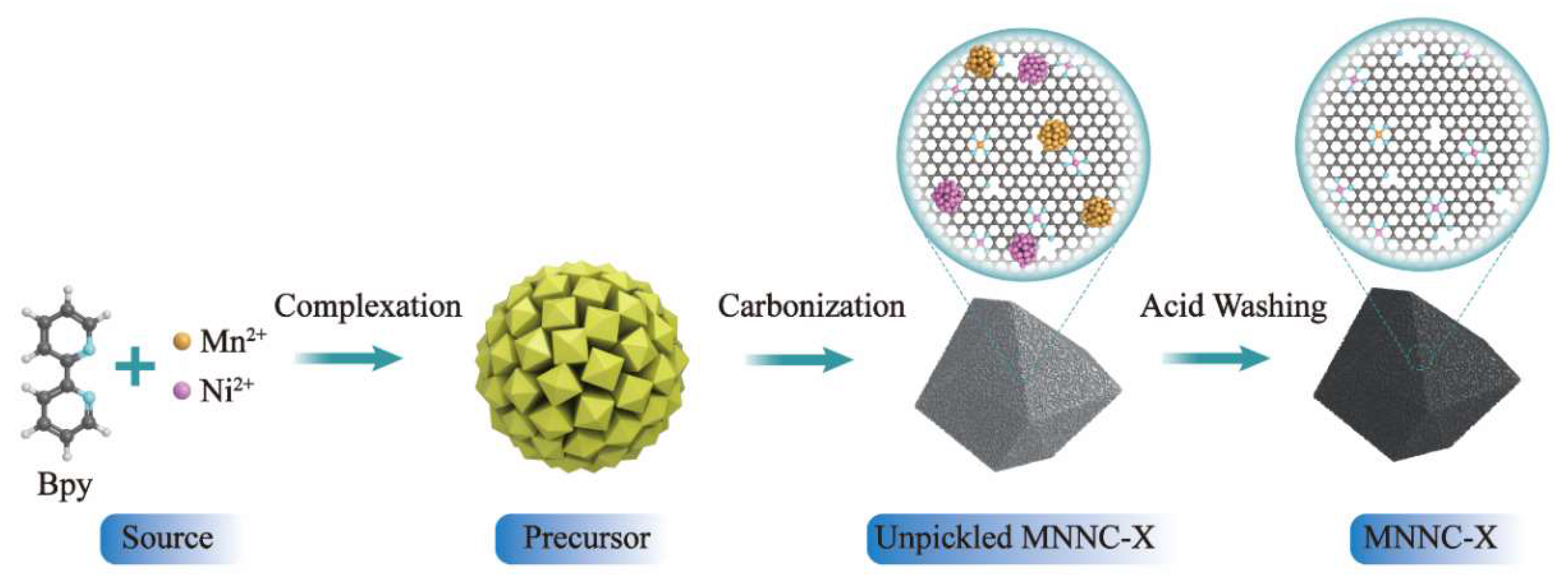
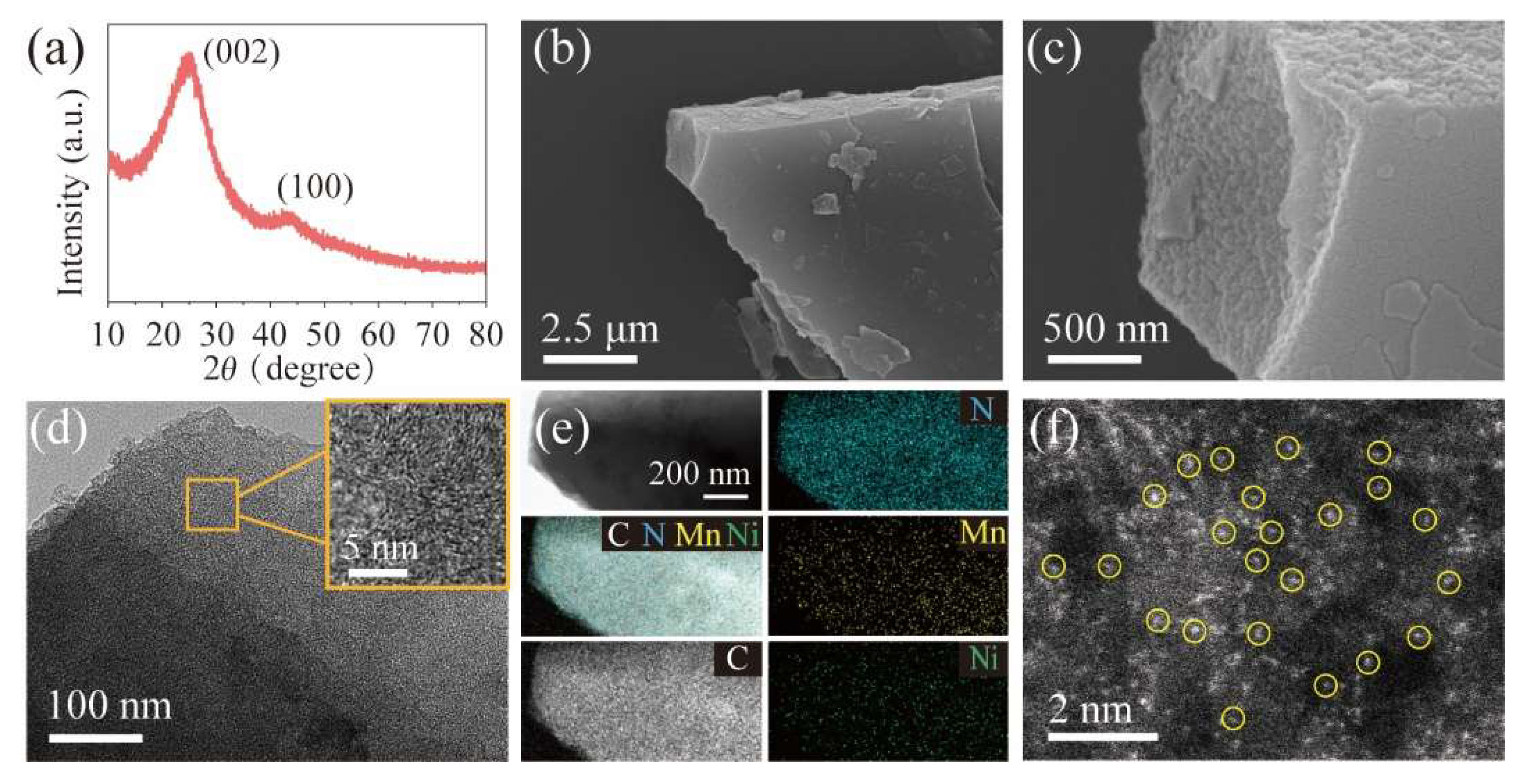
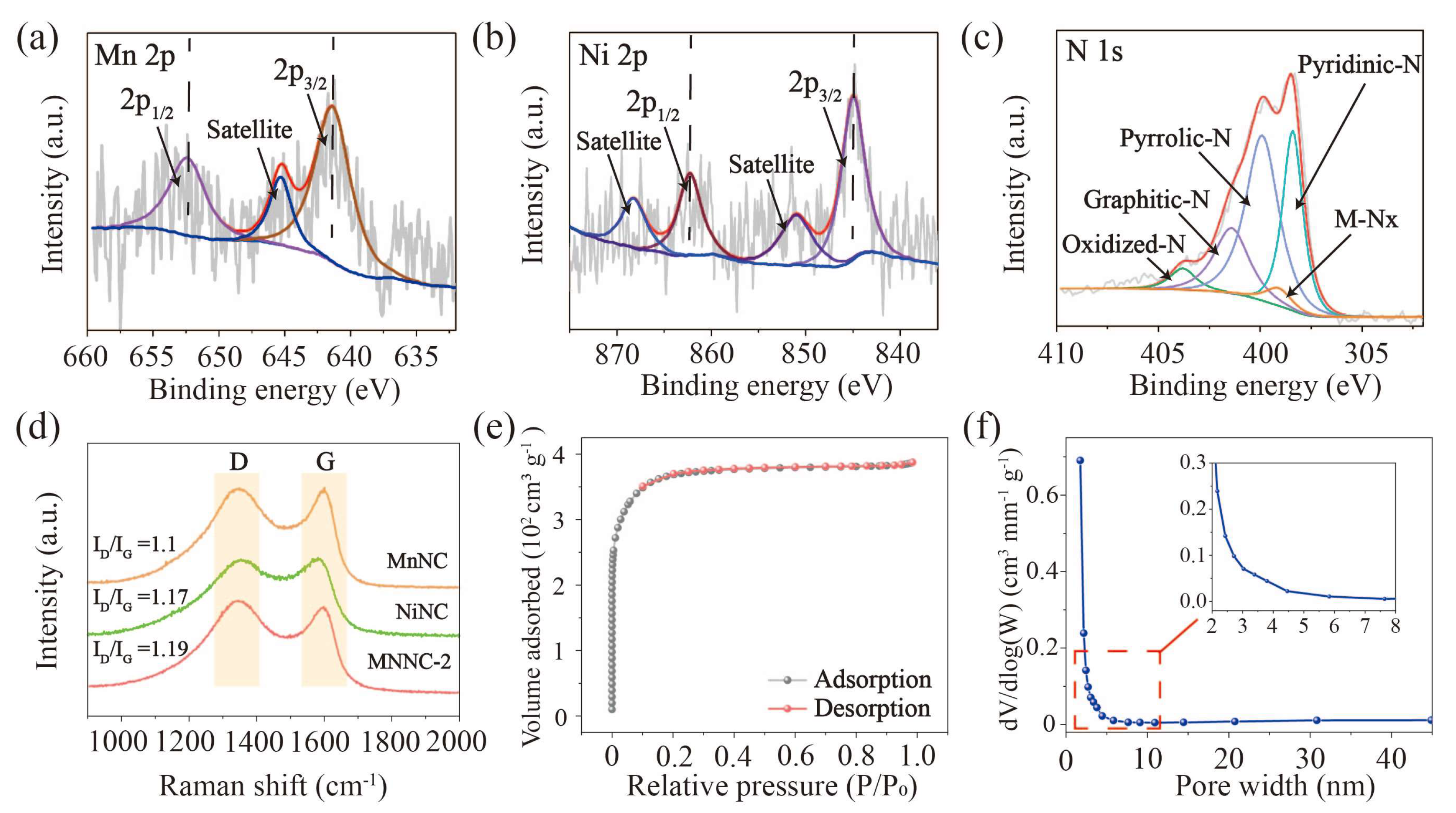
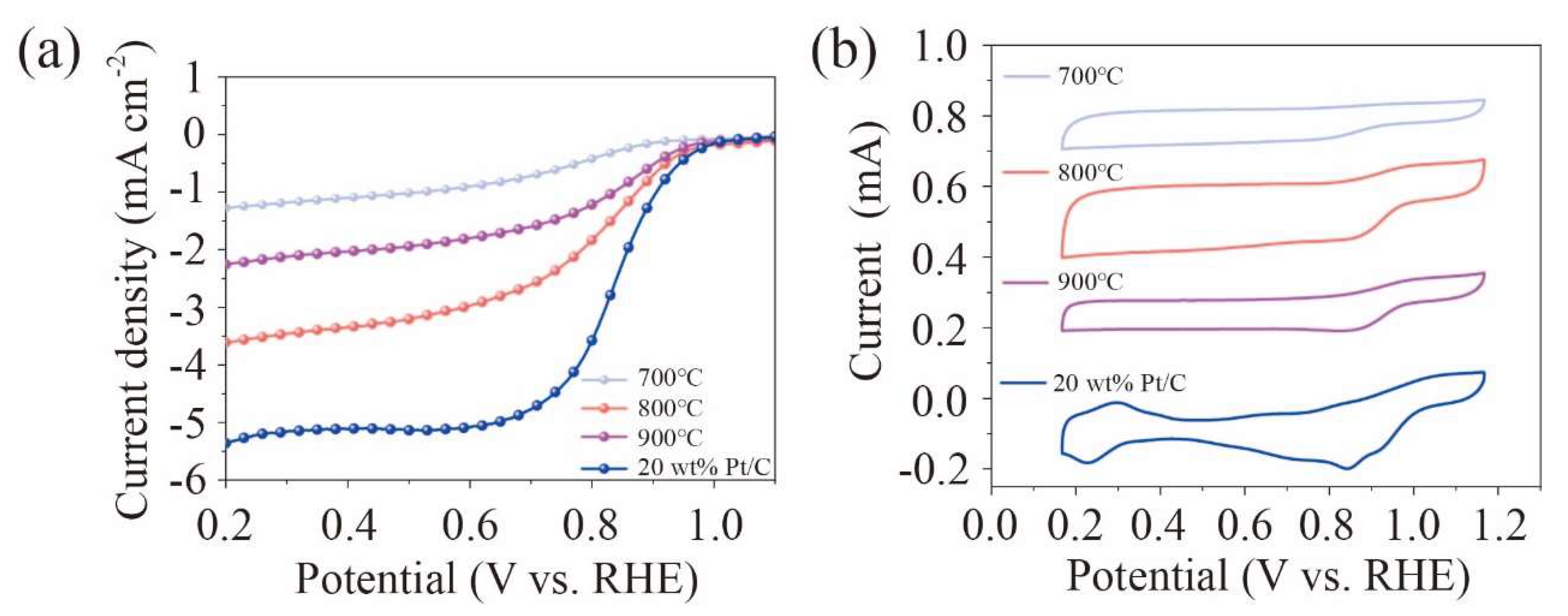
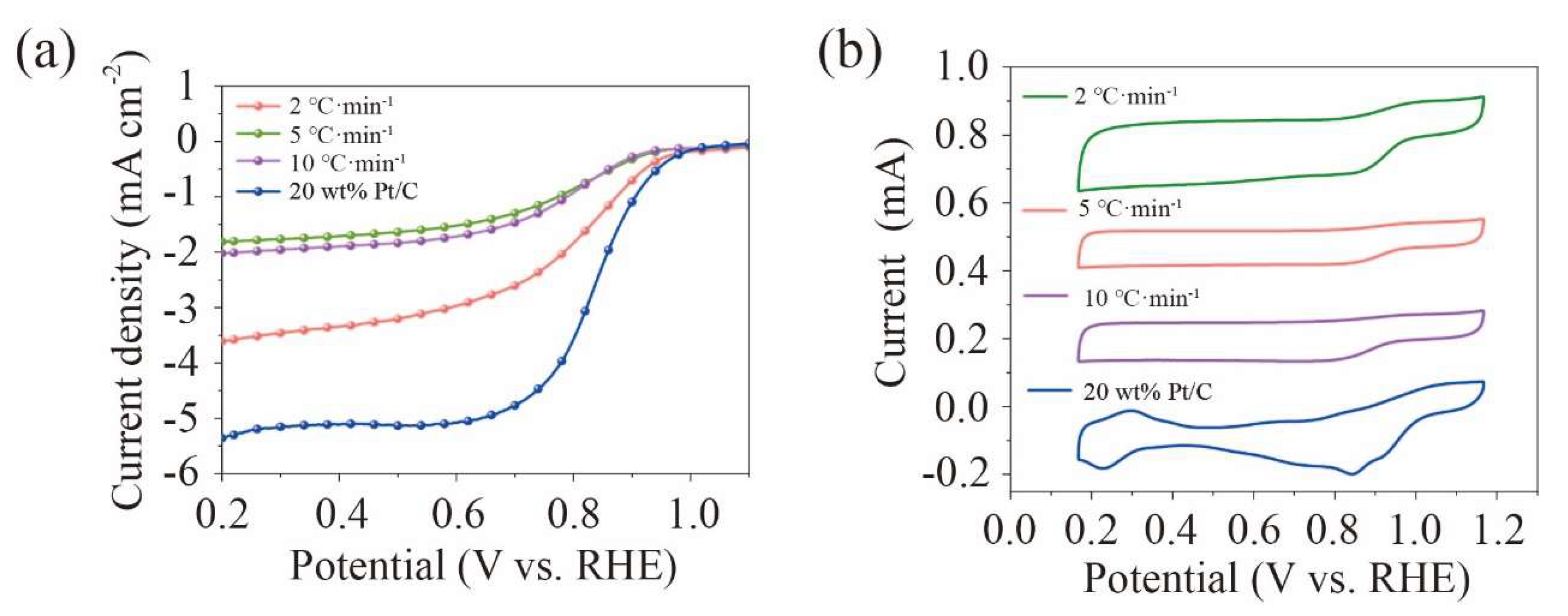
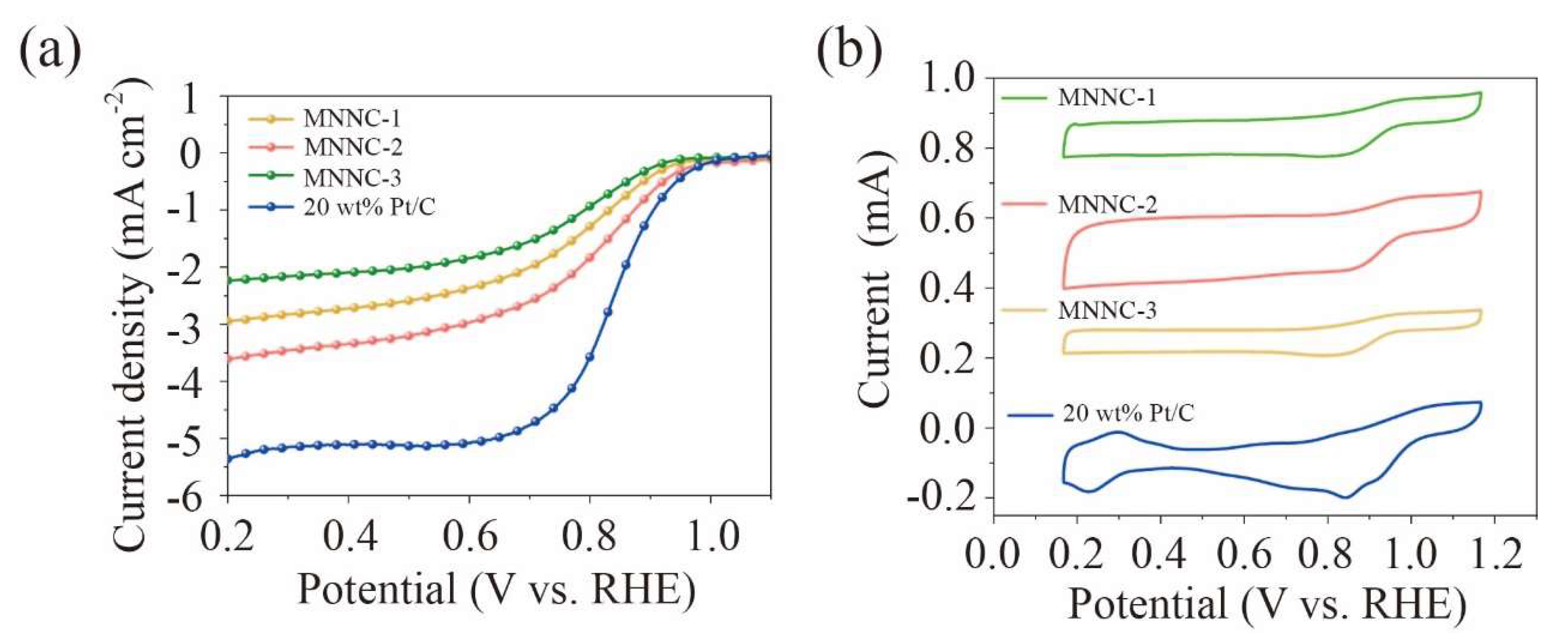
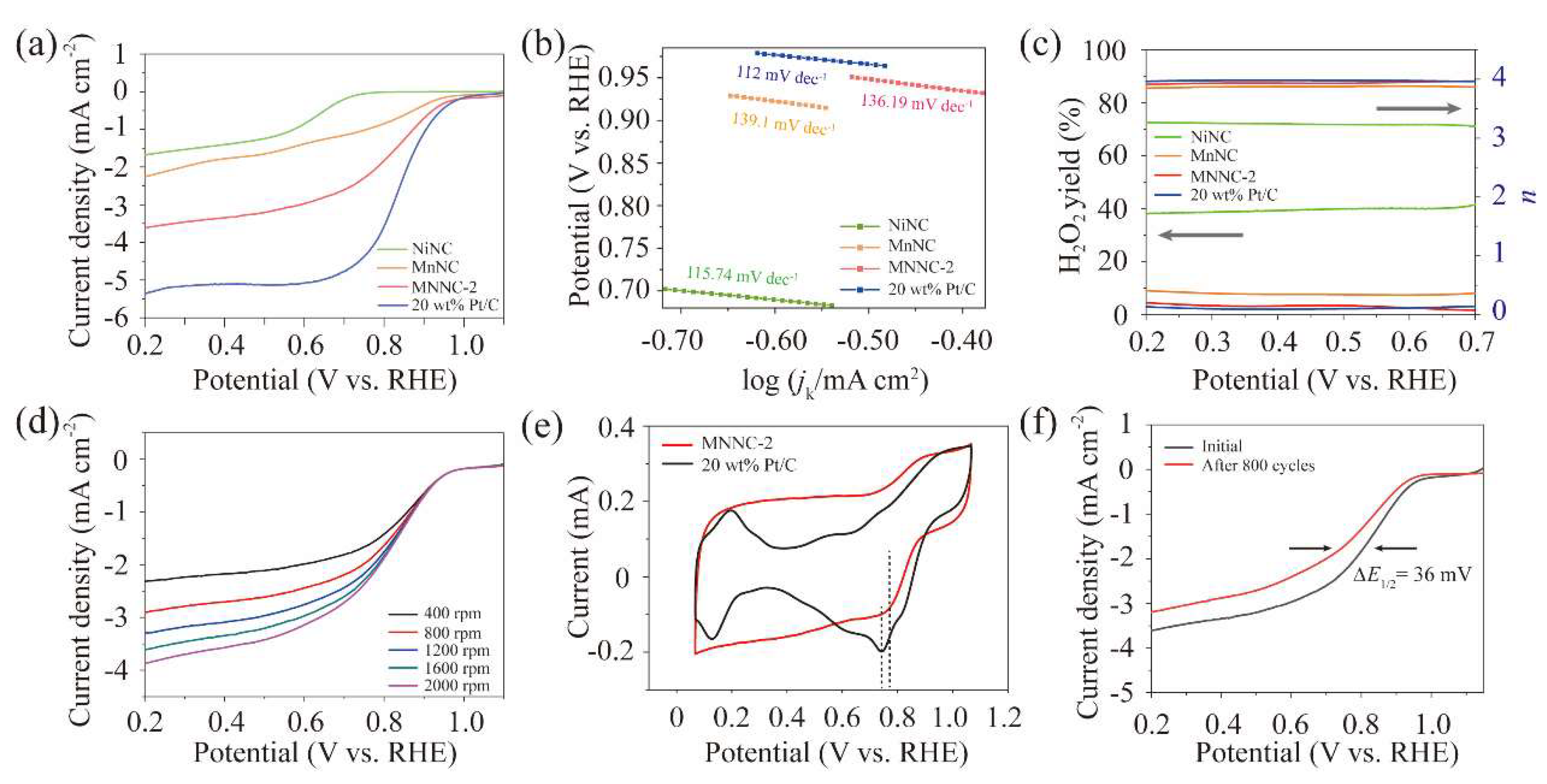
Disclaimer/Publisher’s Note: The statements, opinions and data contained in all publications are solely those of the individual author(s) and contributor(s) and not of MDPI and/or the editor(s). MDPI and/or the editor(s) disclaim responsibility for any injury to people or property resulting from any ideas, methods, instructions or products referred to in the content. |
© 2023 by the authors. Licensee MDPI, Basel, Switzerland. This article is an open access article distributed under the terms and conditions of the Creative Commons Attribution (CC BY) license (https://creativecommons.org/licenses/by/4.0/).
Share and Cite
Sun, Z.; Zhang, S.; Zheng, B.; Zhou, Y.; Chen, W.; Liu, R.; Liu, G.; Lang, L. Metal–Organic Framework-Derived Mn/Ni Dual-Metal Single-Atom Catalyst for Efficient Oxygen Reduction Reaction. Inorganics 2023, 11, 101. https://doi.org/10.3390/inorganics11030101
Sun Z, Zhang S, Zheng B, Zhou Y, Chen W, Liu R, Liu G, Lang L. Metal–Organic Framework-Derived Mn/Ni Dual-Metal Single-Atom Catalyst for Efficient Oxygen Reduction Reaction. Inorganics. 2023; 11(3):101. https://doi.org/10.3390/inorganics11030101
Chicago/Turabian StyleSun, Zewen, Siyuan Zhang, Bo Zheng, Yue Zhou, Wenshu Chen, Rui Liu, Guangxiang Liu, and Leiming Lang. 2023. "Metal–Organic Framework-Derived Mn/Ni Dual-Metal Single-Atom Catalyst for Efficient Oxygen Reduction Reaction" Inorganics 11, no. 3: 101. https://doi.org/10.3390/inorganics11030101
APA StyleSun, Z., Zhang, S., Zheng, B., Zhou, Y., Chen, W., Liu, R., Liu, G., & Lang, L. (2023). Metal–Organic Framework-Derived Mn/Ni Dual-Metal Single-Atom Catalyst for Efficient Oxygen Reduction Reaction. Inorganics, 11(3), 101. https://doi.org/10.3390/inorganics11030101








